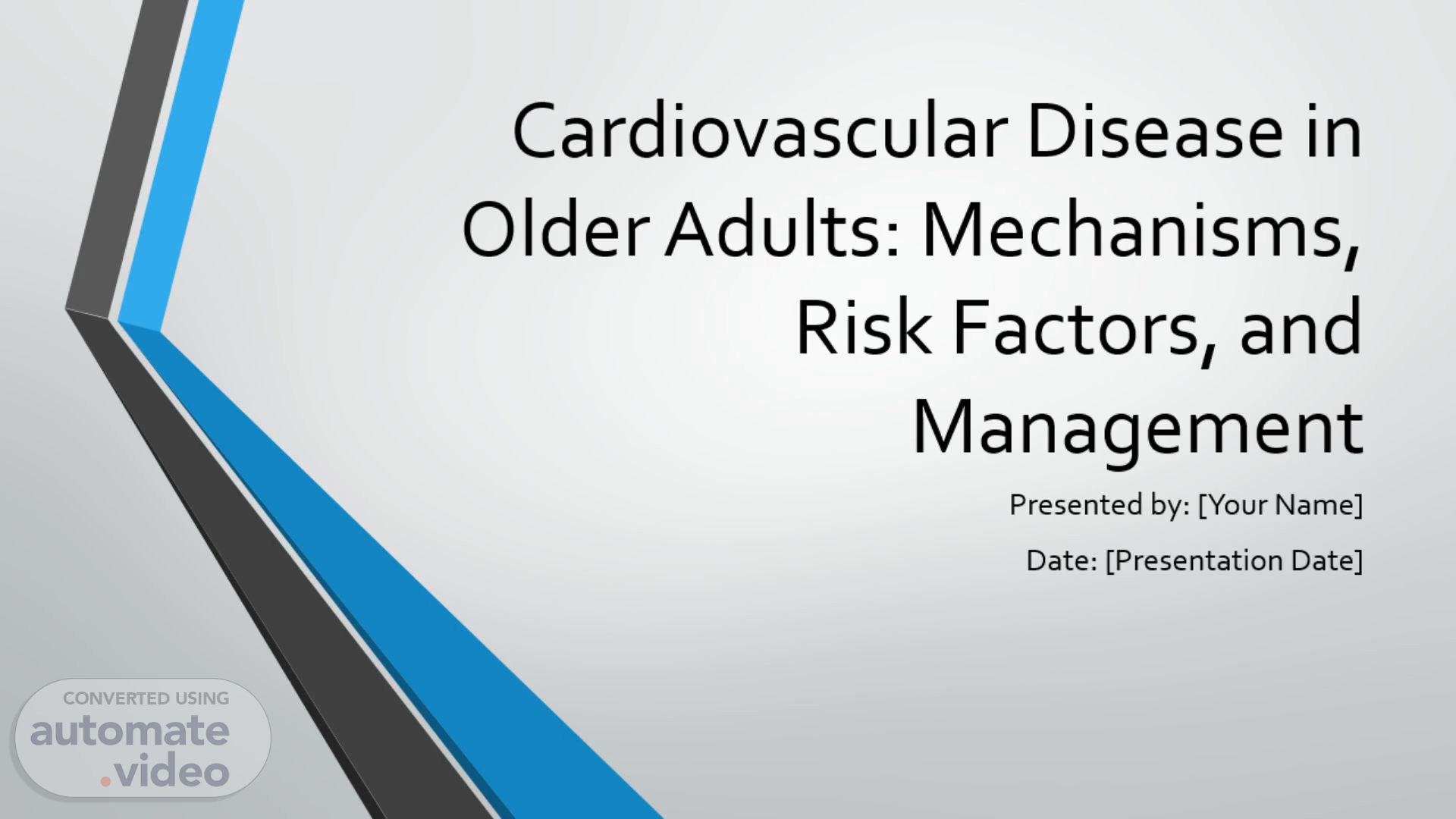
Cardiovascular Disease in Older Adults: Mechanisms, Risk Factors, and Management
Scene 1 (0s)
Cardiovascular Disease in Older Adults: Mechanisms, Risk Factors, and Management.
Scene 2 (9s)
[Audio] Welcome to my presentation on cardiovascular disease in older adults. In this presentation, I will discuss the cardiovascular health challenges faced by aging populations. Specifically, we will look at how aging affects the heart and arteries, and review common health conditions that increase the risk of cardiovascular disease in elderly individuals, such as hypertension, diabetes, and hyperlipidemia.
Scene 3 (36s)
[Audio] Hypertension, or high blood pressure, is a leading cause of cardiovascular diseases in older adults, contributing to heart failure, stroke, and kidney problems (O'Neill & Forman, 2021). Alongside hypertension, hyperlipidemia, or elevated cholesterol levels, increases the risk of atherosclerosis, which contributes to the narrowing of arteries, raising the chances of heart attacks and strokes (Ciumărnean et al., 2021).
Scene 4 (1m 9s)
[Audio] Diabetes significantly raises the risk of cardiovascular diseases due to the damage high blood sugar inflicts on the blood vessels, making the heart more susceptible to diseases like heart failure and stroke (Sagris et al., 2022). Similarly, COPD, or chronic obstructive pulmonary disease, puts additional strain on the heart, especially the right ventricle, which can lead to right-sided heart failure and other cardiovascular complications (Ciumărnean et al., 2021).
Scene 5 (1m 45s)
[Audio] As we age, structural changes in the heart occur, including left ventricular hypertrophy, where the heart muscle thickens, and reduced elasticity, which decreases the heart's ability to pump effectively (O'Neill & Forman, 2021). Additionally, cardiac output decreases with age, which limits the heart's ability to increase its output during physical activity, leaving older adults more susceptible to heart failure and other cardiovascular complications (O'Neill & Forman, 2021).
Scene 6 (2m 20s)
[Audio] As arteries age, they become stiffer, which reduces their ability to stretch with each heartbeat. This leads to higher systolic blood pressure, putting additional strain on the heart (Sagris et al., 2022). Additionally, the stiffening of coronary arteries reduces the blood flow to the heart muscle, increasing the likelihood of ischemia and raising the risk for heart attacks (Ciumărnean et al., 2021)..
Scene 7 (2m 50s)
[Audio] One of the most common changes in the heart muscle with aging is the development of myocardial fibrosis. This results in scarring of the heart tissue, which makes it harder for the heart to contract and pump blood effectively (Sagris et al., 2022). As fibrosis increases, cardiac reserve decreases, meaning the heart cannot increase its output during periods of physical exertion (O'Neill & Forman, 2021).
Scene 8 (3m 19s)
[Audio] Beta-adrenergic receptors are essential for increasing heart rate and force of contraction in response to stress. However, with age, these receptors become less sensitive, which diminishes the heart's ability to increase its rate during exercise or physical stress (Hussain et al., 2020). This reduction in heart rate variability is one of the reasons older adults are more susceptible to heart failure..
Scene 9 (3m 50s)
[Audio] With age, the left ventricle undergoes remodeling, often becoming thicker, which can impair its ability to fill properly (diastolic dysfunction). This contributes to heart failure in the elderly (O'Neill & Forman, 2021). Additionally, older adults are more likely to experience changes in their electrocardiogram (ECG), such as prolonged QT intervals and atrial fibrillation, both of which can increase the risk of stroke and other cardiac events (Sagris et al., 2022).
Scene 10 (4m 27s)
[Audio] As we age, arterial stiffness increases, leading to higher systolic and lower diastolic blood pressure, which contributes significantly to the development of hypertension and cardiovascular disease (Sagris et al., 2022). Additionally, vascular remodeling results in thickening of the arterial walls, which further raises vascular resistance and promotes atherosclerosis (Hussain et al., 2020)..
Scene 11 (4m 58s)
[Audio] Left ventricular hypertrophy, or the thickening of the heart's main pumping chamber, is a common adaptation to aging, especially in response to increased afterload due to higher blood pressure. This can eventually lead to heart failure with preserved ejection fraction (HFpEF), a condition increasingly prevalent in older adults (O'Neill & Forman, 2021). Diastolic dysfunction, caused by reduced ventricle compliance, impairs the heart's ability to fill efficiently, contributing to the development of heart failure (Hussain et al., 2020)..
Scene 12 (5m 38s)
[Audio] As left ventricular dysfunction worsens, symptoms such as shortness of breath, fatigue, and leg swelling become more common. These symptoms are indicative of heart failure, particularly in older adults (O'Neill & Forman, 2021). Additionally, aging-related conduction abnormalities, such as atrial fibrillation and prolonged QT intervals, are frequently observed on the electrocardiogram of elderly patients, highlighting the impact of aging on heart function (Sagris et al., 2022).
Scene 13 (6m 17s)
[Audio] In conclusion, cardiovascular disease in older adults is influenced by a variety of factors, including age-related structural and functional changes in the heart and arteries. The presence of common health conditions like hypertension, hyperlipidemia, and diabetes further exacerbates the risk for heart disease. Early detection and proper management, including lifestyle changes and medications, are key to improving outcomes and maintaining quality of life in the elderly population..
Scene 14 (6m 50s)
References. O'Neill, D. E., & Forman, D. E. (2021). Cardiovascular care of older adults. BMJ, 374, n1593. https://doi.org/10.1136/bmj.n1593 Ciumărnean, L., Milaciu, M. V., Negrean, V., Orășan, O. H., Vesa, S. C., Sălăgean, O., … & Vlaicu, S. I. (2021). Cardiovascular risk factors and physical activity for the prevention of cardiovascular diseases in the elderly. International Journal of Environmental Research and Public Health, 19(1), 207. https://doi.org/10.3390/ijerph19010207 Sagris, M., Antonopoulos, A. S., Theofilis, P., Oikonomou, E., Siasos, G., Tsalamandris, S., … & Tousoulis, D. (2022). Risk factors profile of young and older patients with myocardial infarction. Cardiovascular Research, 118(10), 2281-2292. https://doi.org/10.1093/cvr/cvab209 Hussain, M., Jabeen, S., Khan, M. A., & Imran, M. (2020). Beta-adrenergic signaling and aging: Mechanisms and therapeutic approaches. Journal of Clinical Medicine, 9(5), 1356. https://doi.org/10.3390/jcm9051356.